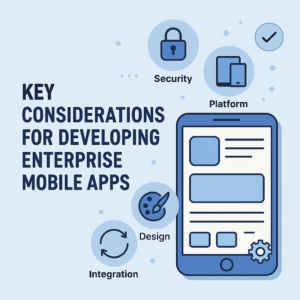Building a Scalable Mobile App Architecture: Key Concepts and Best Practices
In today’s rapidly evolving tech landscape, mobile apps are expected to handle increasing loads, provide seamless user experiences, and scale with growing user bases. A scalable mobile app architecture isn’t just about dealing with increased traffic; it’s about designing an app that can adapt to new requirements, integrate new features, and continue to perform well as demand grows. In this article, we’ll break down the essential principles, patterns, and best practices for building a scalable mobile app architecture.
1. What Does Scalability Mean for Mobile Apps ?
Scalability in mobile app development is the ability of an app to handle an increase in usage, traffic, or functionality without significant drops in performance. In practical terms, scalability involves:
- Handling more users: Supporting increasing numbers of active users without crashes or slowdowns.
- Efficient data management: Ensuring the app can handle more data without degrading user experience.
- Flexible backend: Having an architecture that can scale in terms of both processing power and storage.
- Codebase growth: Ensuring the code remains maintainable and easy to extend over time.
Creating a scalable app means preparing for the future, ensuring that the system can adapt to the needs of tomorrow while being easy to maintain and update.
2. Core Principles of Scalable Mobile App Architecture
When designing scalable mobile apps, there are several foundational principles that will guide the development process.
2.1 Modularization
- Separation of Concerns: Divide the app into distinct, self-contained modules. Each module should focus on a single task, like user interface management, business logic, or data management. This allows different parts of the app to evolve independently.
- Reusability: Design components that can be reused in multiple places within the app or across different projects, which simplifies maintenance and reduces development time.
- Single Responsibility: Following the single responsibility principle, where each class or module does one thing, helps keep the app flexible and easier to test.
2.2 Asynchronous Operations
Mobile devices have limited resources compared to desktop environments. Therefore, handling long-running tasks asynchronously is key to maintaining app performance.
- Background Processing: Tasks like network requests, file I/O, or complex calculations should run in the background to avoid blocking the main UI thread.
- Non-blocking APIs: Use asynchronous APIs for any network or database calls. This ensures that the user interface remains responsive even while data is being fetched or processed in the background.
2.3 Effective Caching
Caching helps in reducing the load on the backend and speeds up data access by storing data locally.
- Local Caching: Store frequently accessed data locally on the device. This can be in-memory caches or local databases (such as SQLite or Realm), which reduces the need for repeated network requests.
- Remote Caching: On the server side, use caching strategies to reduce the frequency of expensive database queries or API calls.
- Cache Management: Implement strategies for cache invalidation to ensure that users always see up-to-date data without unnecessary delays.
2.4 Scalable Backend Design
A scalable mobile app doesn’t just rely on client-side design but also requires a backend that can grow with the app. As traffic increases, so must the backend’s capacity.
- Microservices Architecture: Rather than relying on a monolithic backend, break your backend into microservices. This allows each service to scale independently based on its demand, without overloading other parts of the system.
- Serverless Technologies: Cloud services like AWS Lambda or Google Cloud Functions allow for automatic scaling of individual backend functions without the need to manage infrastructure.
- API Rate Limiting: Implementing rate limiting ensures that your APIs can handle increased traffic without becoming overloaded, protecting both backend resources and maintaining fair usage.
2.5 Data Synchronization and Management
Effective data synchronization is essential for apps that rely on real-time or offline capabilities.
- Offline Capabilities: Users may be offline at times, so your app should support offline mode and synchronize data when a network connection becomes available.
- Data Consistency: Implement mechanisms to resolve data conflicts when the app is used across multiple devices or when the network connection is intermittent.
- Optimized Database Queries: As the app grows, database queries must remain efficient. Use techniques like indexing, pagination, and query optimization to maintain performance.
3. Popular Mobile App Architecture Patterns
Choosing the right architecture pattern is crucial for scaling the app in the long term. Let’s explore some common mobile app architectural patterns.
3.1 Model-View-ViewModel (MVVM)
MVVM is an architecture that separates the app’s data model, UI, and presentation logic. This is often preferred in apps with complex UI logic.
- Benefits:
- Facilitates unit testing since business logic and UI are decoupled.
- The ViewModel holds state, which simplifies handling complex UIs.
- Well-suited for apps that need to handle complex, data-driven UIs with dynamic content.
3.2 Model-View-Presenter (MVP)
MVP is similar to MVVM, but here the Presenter takes on more responsibility for processing user input and updating the UI. The View’s role is limited to displaying data provided by the Presenter.
- Benefits:
- Ideal for apps with intricate UI logic that needs more control over data presentation.
- Makes the app easier to test, as the business logic is separated from the UI layer.
3.3 Clean Architecture
Clean Architecture divides an app into distinct layers, such as Entities, Use Cases, Interface Adapters, and Frameworks. It emphasizes separation between the app’s core business logic and external dependencies like UI frameworks and databases.
- Benefits:
- Offers maximum flexibility and scalability as the app evolves.
- Makes it easy to swap out components (e.g., changing the UI framework or the database) without affecting core business logic.
- Highly maintainable and testable due to its clear separation of concerns.
4. Best Practices for Scalable Mobile App Development
Here are a few additional best practices to help ensure your mobile app is scalable:
4.1 Use Dependency Injection (DI)
Dependency injection allows the decoupling of components, making your code more modular, flexible, and easier to test. DI frameworks, such as Dagger or Hilt, can help manage dependencies automatically.
4.2 Automate with CI/CD
A continuous integration and continuous delivery (CI/CD) pipeline ensures that your app is regularly tested, built, and deployed. Automating this process reduces the risk of errors and allows you to release new features and updates quickly and reliably.
4.3 Monitor Performance and Collect Analytics
Performance monitoring tools like Firebase Performance Monitoring, Sentry, or New Relic can help you detect issues such as crashes, slow load times, and excessive memory usage. Additionally, user analytics tools can provide insights into how your app is being used and help prioritize improvements.
4.4 Keep Dependencies Updated
It’s crucial to regularly update third-party libraries and dependencies to benefit from bug fixes, security patches, and performance improvements. Keeping your dependencies up-to-date ensures that the app is not only secure but also efficient as it scales.
5. Conclusion
Building a scalable mobile app architecture requires a deep understanding of both the app’s current and future needs. A modular design, efficient data management, and asynchronous processing are essential for scalability. Choosing the right architecture pattern—whether MVVM, MVP, or Clean Architecture—can provide the necessary structure for growth. In addition, following best practices like dependency injection, CI/CD, and performance monitoring can further ensure that the app remains scalable, maintainable, and high-performing as it evolves.
By focusing on these principles and strategies, developers can create mobile applications that not only meet the demands of users today but also scale gracefully as they grow in complexity and usage. Scalability is not just about handling more users, but about creating a flexible foundation that allows the app to adapt to new challenges and opportunities in the future.





